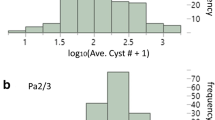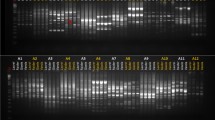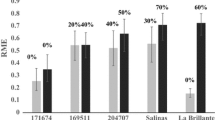Abstract
The inheritance of mefenoxam resistance in the oomycetePhytophthora erythroseptica, causal organism of pink rot of potato, was investigated in two successive selfed generations of single oospore isolates. Fourteen parental isolates from three mefenoxam-sensitivity phenotypes (sensitive, intermediately resistant, and resistant) were used to produce S1 and S2 progeny isolates by selfing each isolate and germinating single oospore cultures from each isolate. The two generations of isolates were tested for mefenoxam sensitivity using the radial growth inhibition assay and calculating EC50 values. Twenty-four-hundred isolates from S1 and S2 generations were tested for mefenoxam sensitivity. Results demonstrated the lack of segregation for mefenoxam sensitivity among S1 and S2 progeny isolates from the resistant and sensitive parents. The majority of the S1 progeny isolates from the parents with intermediate resistance also possessed intermediate resistance, but demonstrated substantial quantitative shifts in response to mefenoxam more often toward increased insensitivity. A few isolates from the S1 progeny were sensitive to mefenoxam, and one isolate was mefenoxam-resistant. Similarly, the majority of the S2 progeny isolates from intermediately resistant parents also possessed intermediate resistance with some quantitative shifts in sensitivity to mefenoxam similar to those observed in S1 progeny, as well as a few isolates that were sensitive to mefenoxam. These results do not support the hypothesis that resistance to mefenoxam inP. erythroseptica is controlled by a single gene exhibiting incomplete dominance. Alternative hypotheses are proposed such as the genetics of mefenoxam resistance inP. erythroseptica is probably under the control of more than one major gene and perhaps some minor genes of additive effect.
Resumen
La herencia de la resistencia del oomycetePhytophthora erythroseptica causante de la pudrición rosada de la papa al mefenoxam fue investigada en dos generaciones autofecundadas sucesivas de aislamientos provenientes de una sola oospora. Catorce aislamientos de tres fenotipos sensibles al mefenoxam (sensible, intermedio-resistente y resistente) fueron utilizados para producir los aislamientos progenle S1 y S2, autofecundando cada aislamiento y produciendo aislamientos provenientes de una sola oospora. Se probaron los aislamientos de las dos generaciones para sensibilidad al mefenoxam, utilizando la prueba de inhibición de crecimiento radial y calculando los valores EC50. Se probaron 2,400 aislamientos de las generaciones S1 y S2 para determinar su sensibilidad al mefenoxam. Los resultados demostraron la falta de segregación para sensibilidad a la acción del mefenoxam entre los aislamientos de las progenies S1 y S2 provenientes de progenitores resistentes y sensibles. La mayoría de los aislamientos de la progenie S1 provenientes de progenitores con resistencia intermedia también tuvieron resistencia intermedia, pero demostraron un cambio cuantitativo sustancial en respuesta al mefenoxam, con más frecuencia hacia una mayor insensibilidad. Unos pocos aislamientos de la progenie S1 mostraron sensibilidad al mefenoxam y un aislamiento mostró resistencia. De la misma manera, la mayoria de los aislamientos de la progenie S2 con progenitores de resistencia intermedia, tuvieron también resistencia intermedia con algunos cambios cuantitativos en sensibilidad, similares a aquellos observados en la progenie S1 e igualmente linos pocos aislamientos fueron sensibles. Estos resultados no apoyan la hipótesis de que la resistencia delP. erythroseptica al mefenoxam es controlada por un solo gen de dominancia incompleta. Se propone la hipótesis alternativa de que la resistencia genética delP. erythroseptica al mefenoxam está probablemente bajo el control de más de un gen mayor y tal vez de algunos genes menores de efecto aditivo.
Similar content being viewed by others
Literature Cited
Bhat RG, BA McBlain, and AF Schmitthenner. 1993. The inheritance of resistance to metalaxyl and to fluorophenylalanine in matings of homothallicPhytophthora sojae. Mycol Res 97:865–870.
Chabane K, P Leroux, N Maia, and G Bompeix. 1996. Resistance to dimethomorph in laboratory mutants ofPhytophthora parasitica. In: H Lyr, PE Russell, and HD Sisler (eds), Modern Fungicides and Antifungal Compounds, 11th International Symposium. Intercept Limited, Andover, UK. pp 387–391.
Chang TT, and WH Ko. 1990. Resistance to fungicides and antibiotics inPhytophthora parasitica: Genetic nature and use in hybrid determination. Phytopathology 80:1414–1421.
Crute IR. 1987. The occurrence, characteristics, distribution, genetics, and control of a metalaxyl-resistant phenotypes ofBremia lactucea in the United Kingdom. Plant Dis 71:763–767.
Crute IR, and JM Harrison. 1988. Studies on the inheritance of resistance to metalaxyl inBremia lactucea and on the stability and fitness of field isolates. Plant Pathol 37:231–250.
Davidse LC, AE Hofman, and GCM Velthuis. 1983. Specific interference of metalaxyl with endogenous RNA polymerase activity in isolated nuclei fromPhytophthora megasperma f. sp.medicaginis. Experimental Mycol 7:344–361.
Davidse LC, GCM Velthuis, BC Mentel, and ABL Jespers. 1991. Phenylamidesand Phytophthora. In: JA Lucas, RC Shattock, DS Shaw, and LR Cooke (eds),Phytophthora. British Mycological Society, Cambridge, UK. pp 349–360.
Fabritius, AL, RC Shattock, and HS Judelson. 1997. Genetic analysis of metalaxyl insensitivity loci inPhytophthora infestans using linked DNA markers. Phytopathology 87:1034–1040.
Goodwin SB, and MT McGrath. 1995. Insensitivity to metalaxyl among isolates ofPhytophthora erythroseptica causing pink rot of potato in New York. Plant Dis 79:967.
Goodwin SB, LS Sujkowski, and WE Fry. 1996. Widespread distribution and probable origin of resistance to metalaxyl in clonal genotypes ofPhytophthora infestans in the United States and Western Canada. Phytopathology 86:793–800.
Goodwin SB. 1997. Wright’s fixation index analysis reveals the probable mating system for 16 species ofPhytophthora. Proceedings of the 19th fungal genetics conference, Abstract No. 120, Asilomar, CA.
Gudmestad NC, B Salas, RJ Taylor, VV Rivera, and GA Secor. 2000. Assessment of mefenoxam resistance inPhytophthora erythroseptica in the USA. Proc. Brighton Crop Prot. Conf. 2000-Pests and Diseases 2:435–440.
Heaney SP, AA Hall, SA Davies, and G Olaya. 2000. Resistance to fungicides in the QoI-STAR cross-resistance group: Current perspectives. Brighton Crop Protection Conference. 2000-Pests and Diseases 2:755–762.
Ishii H, BA Fraaije, T Sugiyama, K Noguchi, K Nishimura, T Takeda, T Amano, and DW Hollomon. 2001. Occurrence and molecular characterization of strobilurin resistance in cucumber powdery mildew and downy mildew. Phytopathology 91:1166–1171.
Judelson HS, and S Roberts. 1999. Multiple loci determining insensitivity to phenylamide fungicides inPhytophthora infestans. Phytopathology 89:754–760.
Kuehl RO. 1994. Statistical Principles of Research Design and Analysis. Duxbury Press, Belmont, CA.
Lambert DH, and B Salas. 1994. Metalaxyl insensitivity ofPhytophthora erythroseptica isolates causing pink rot of potato in Maine. Plant Dis 78:1010.
Lambert DH, and B Salas. 2001. Pink rot. In: WR Stevenson, R Loria, GD Franc, and DP Weingartner (eds), Compendium of Potato Diseases. American Phytopathological Society Press, St. Paul, MN. pp 33–34.
Lee TY, E Mizubuti, and WE Fry. 1999. Genetics of metalaxyl resistance inPhytophthora infestans. Fungal Gen Biol 26:118–130.
Lucas JA, G Greer, PV Oudemans, and MD Coffey. 1990. Fungicide sensitivity in somatic hybrids ofPhytophthora capsici by protoplast fusion. Physiol Mol Plant Pathol 36:175–187.
Medina MV, and HW Platt. 1999. Viability of oosporesof Phytophthora infestans under field conditions in northern North America. Can J Plant Pathol 21:137–143.
Michelmore RW, I. Paran, and RV Kesseli. 1991. Identification of markers linked to disease resistance genes by bulk segregant analysis: A rapid method to detect markers in specific genomic regions using segregating polymorphisms. Proc Nat Acad Sci USA 88:9828–9832.
Minitab, Inc. 1997. Minitab for Windows, Minitab Release 12.01. Minitab Inc., State College, PA.
Peters RD, AV Sturz, and WJ Arsenault. 2003. Use of mefenoxam to control pink rot (Phytophthora erythroseptica) of potato in Prince Edward Island. Can J Plant Pathol 25:33–40.
Peters RD, AV Sturz, BG Matheson, WJ Arsenault, and A Malone. 2001. Metalaxyl sensitivity of isolates ofPhytophthora erythroseptica in Prince Edward Island. Plant Pathol 50:302–309.
Salas B, RW Stack, GA Secor, and NC Gudmestad. 2000. The effect of wounding, temperature, and inoculum on the development of pink rot of potatoes caused byPhytophthora erythroseptica. Plant Dis 84:1327–1333.
Shattock RC. 1988. Studies on the inheritance of resistance to metalaxyl inPhytophthora infestans. Plant Pathol 37:4–11.
Stack RW, B Salas, NC Gudmestad, GA Secor. 1993. The lake of evidence for metalaxyl resistance inPhytophthora erythroseptica, the cause of pink rot of potato. Phytopathology 83:886.
Taylor RJ, B Salas, GA Secor, V Rivera, and NC Gudmestad. 2002. Sensitivity of North American isolates ofPhytophthora erythroseptica andPythium ultimum to mefenoxam (metalaxyl). Plant Dis 86:797–802.
Vincelli P, and E Dixon. 2002. Resistance to QoI (Strobilurin-like) fungicides in isolates ofPyricularia grisea from perennial ryegrass. Plant Dis 86:235–240.
Author information
Authors and Affiliations
Rights and permissions
About this article
Cite this article
Samen, F.M.AE., Oberoi, K., Taylor, R.J. et al. Inheritance of mefenoxam resistance in selfed populations of the homothallic oomycetePhytophthora erythroseptica (Pethybr.), cause of pink rot of potato. Am. J. Pot Res 82, 105–115 (2005). https://doi.org/10.1007/BF02853647
Accepted:
Issue Date:
DOI: https://doi.org/10.1007/BF02853647




